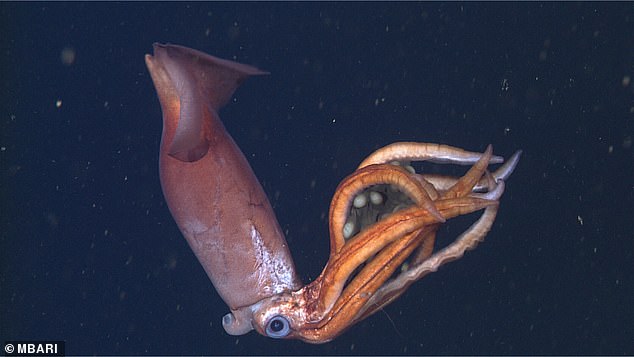A rare deep-sea squid, captured more than 1,800 feet below sea level by a submersible drone, is now believed to be a new species after nearly a decade of analysis.
Marine biologists first took note of the mother squid, now officially described as part of the family. gonatidae – in the Gulf of California off the coast of Baja California, where it was caught cradling eggs that were twice as large as any seen before.
Normally, deep-sea squid produce thousands of tiny eggs, up to 3,000 at a time, but the new species Instead, she was seen holding and protecting only 30 to 40 much larger eggs.
The researchers suspect that the lack of predators in the deep sea, or possibly a more stable food supply, allowed this squid to develop reproductive habits that devoted more resources to fewer eggs, rather than the quick approach of many tiny eggs.
A rare deep-sea squid, captured on video more than 1,800 feet below sea level using a submersible drone, is now believed to be a new species after nearly a decade of analysis. Above, a fragment of that 2015 video of the deep-sea squid, described as a possible new species of the family. gonatidae
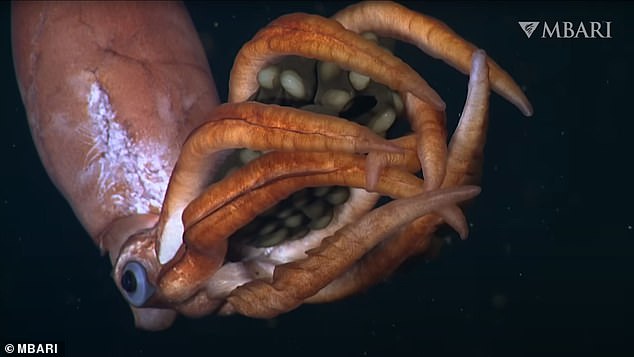
Typically, deep-sea squid produce up to 3,000 much smaller eggs, in what experts called a “bet-hedging” strategy that these creatures evolved to increase their species’ chances of survival. The new squid (above) was seen with only 30 to 40 much larger eggs.
The strange 2015 encounter sparked a nine-year investigation by scientists from the United States and Germany, who described the “giant size of the eggs” as “unprecedented.”
“Our unexpected encounter with a squid incubating giant eggs,” scientist Steven Haddock of California’s Monterey Bay Aquarium Research Institute (MBARI) told reporters, “caught the attention of everyone in the control room of the ship”.
All previous deep sea squid in this gonatidae o The Gonatus family has been recorded to reproduce through eggs that are no larger than a quarter of an inch (six millimeters).
Scientists called this more traditional approach to squid, with many tiny eggs, a “bet-hedging” strategy that the creatures evolved to increase their species’ chances of survival in parts of the ocean where predators eat squid and their eggs.
But the 2015 mother squid was incubating eggs nearly twice that size wrapped inside her protective tentacles, estimated to be about half an inch (11.6 millimeters) in diameter.
The unexplained difference put scientists on the hunt for a good evolutionary reason why any deep-sea squid could reproduce this way.
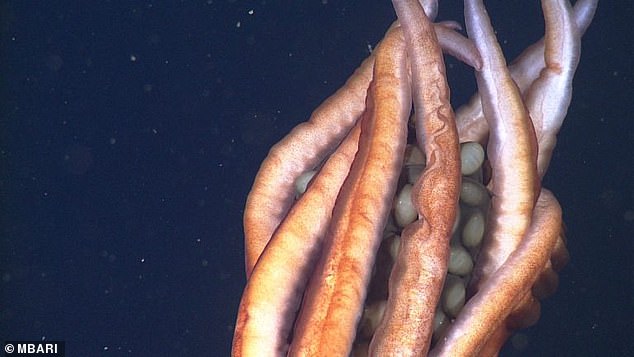
“Our unexpected encounter with a squid hatching giant eggs,” a scientist at California’s Monterey Bay Aquarium Research Institute told reporters, “caught the attention of everyone in the ship’s control room.” In close-up are the eggs, which measure about half an inch in diameter.
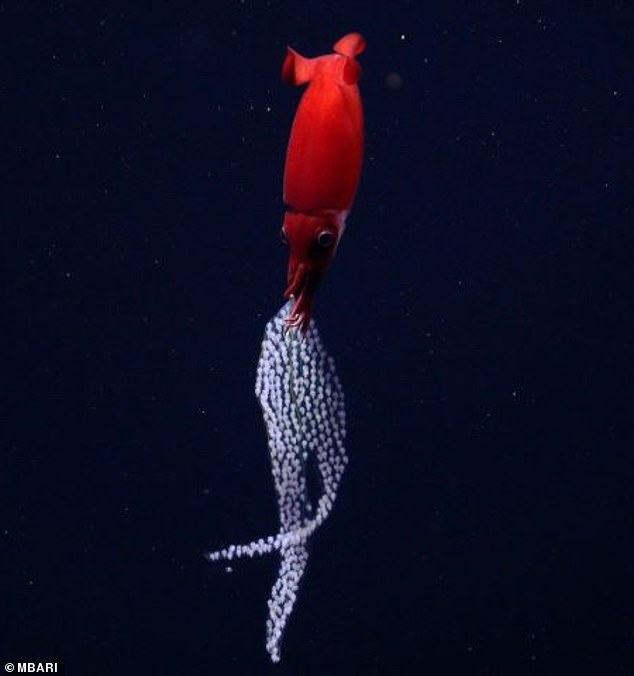
All previous deep sea squid in this gonatidae o The Gonatus family has been recorded to reproduce through eggs that are no larger than a quarter of an inch (six millimeters). Above, the squid Bathyteuthis berryi documented with a more typical brood of smaller squid eggs
“This remarkable sighting underscores the diversity of ways animals adapt to the unique challenges of living in the deep,” according to MBARI’s Haddock, who was the chief scientist of the expedition that videotaped the squid for the first time.
Data gleaned from other marine biologists’ research on the gestation period of squid eggs only deepened the mystery.
Based on the frigid ocean temperatures involved and the sizes of other deep-sea squid with well-documented “egg development rates,” the researchers estimated that the eggs of this new gonatidae The squid can take up to four years to develop.
“Raising requires a lot from a squid mother,” Hoving said in a statement. MBARI. “It does not eat while carrying its eggs and eventually dies after the eggs hatch.”
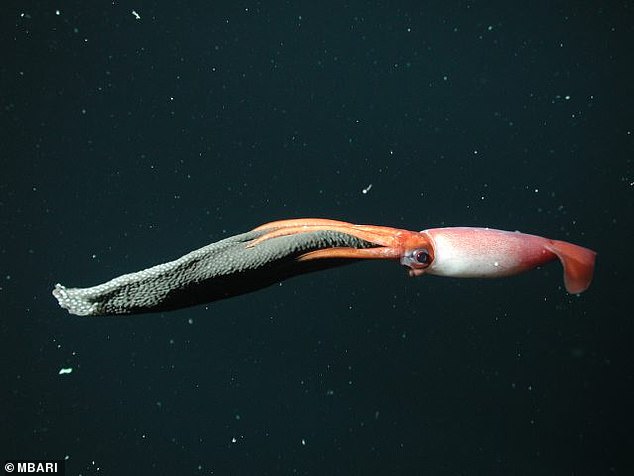
Above, a mother black-eyed squid (gonate onyx) incubating a much larger set of more typical and much smaller squid eggs
“But their sacrifice improves the chances that their offspring will survive,” said Hoving, who now heads the deep-sea biology working group at GEOMAR, the Helmholtz Center for Ocean Research in Kiel, Germany.
“It’s just one of many notable adaptations that may help cephalopods (the technical term for squid and octopus species) survive in the deep sea.”
A period of years of a mother squid caring for her eggs, with this level of sacrifice and resolve, would make this species an incredible outlier compared to other squid.
“If the parenting time is really longer than one year,” the research team wrote in their new study published in the journal Ecology“lasts longer than the entire life cycle of most coastal and shallow-water cephalopods (both squid and octopuses).”
Right now, researchers suspect that this squid evolved to produce fewer and larger eggs, because its isolated deep-sea ecosystem has few baby squid predators.
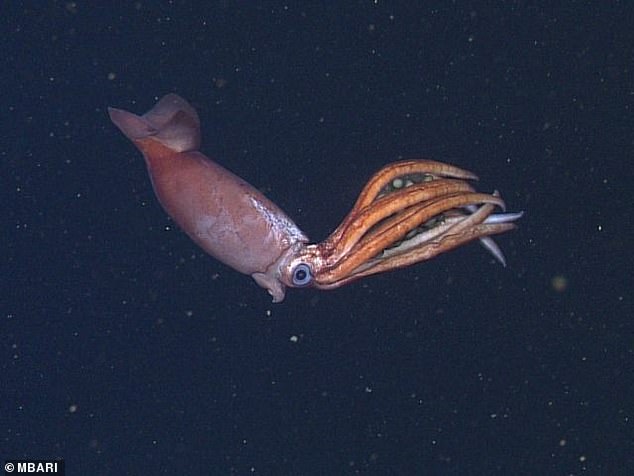
“Breeding takes a lot out of the mother squid,” the lead author of the new study said in a statement. ‘She does not eat while she carries her eggs and eventually dies after the eggs hatch’
Two species of deep-sea octopus, the deep-sea warty octopus (Graneledona sp.) and the pearl octopus (Muusoctopus robustus), they also lay larger than normal eggs.
The fact that this is a trend in deep-sea regions, the team noted, could suggest that “more stable and predictable conditions” at depth allow these creatures to metaphorically put all their eggs in one basket.
“Giant eggs may be more beneficial,” the team wrote in a statement, “allowing greater investment in fewer offspring that have a better chance of survival.”
The new study, a collaboration between MBARI in California, GEOMAR in Germany, and the University of Florida, hopes to collect more specimens to more solidly confirm that this squid is definitely a new species.
Despite the crucial role that deep-sea squid play in the broader ocean food chain, and even in the commercial fishing industry, marine science currently understands very little about these creatures.
Deep-sea squid eat small fish and invertebrates and then, in turn, become food for commercially important fish such as tuna, swordfish, and billfish. But their life cycle and range remain big open questions, the researchers said.
“Advanced underwater robots are helping us better understand the lives of deep-sea squid, revealing new and fascinating information about their biology and behavior,” according to Hoving.
“But we still have a lot to learn about deep-dwelling squid,” he added.
“The deep sea is the largest living space on Earth,” added MBARI’s Haddock, “and much remains to be discovered.”

